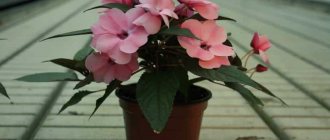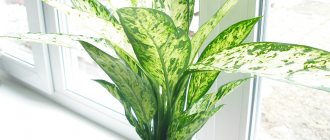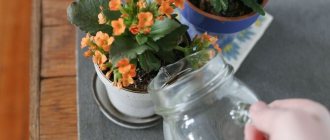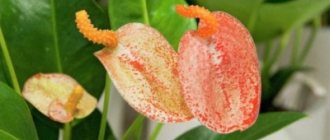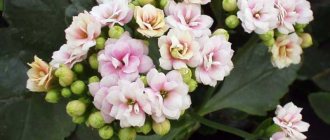The exotic plant Kalanchoe blossfeldiana belongs to the Crassulaceae family. The birthplace of the flower is Madagascar. Thanks to the famous German botanist Robert Blossfeld, the flower got its name. It was Blossfeld who first introduced this type of Kalanchoe to European society at the beginning of the 20th century.
Briefly about care
| Type of agricultural operation for caring for Kalanchoe Blossfeld | Description of conditions and actions |
| Watering and air humidity | spring and autumn - once every 2 weeks, summer - once a week, winter - once every 3 weeks; You can wipe the leaves from dust |
| Lighting organization | bright diffused sunlight; In winter, lighting may be required; In summer, shading is needed |
| Maintaining a rest period | no rest period |
| Creating temperature conditions | the air temperature should not be higher than 25 °C and lower than 10 °C |
| Trimming | After the succulent has faded, it is necessary to remove the flower stalks |
| Making soil mixture | the substrate should consist of sand and compost soil |
| Fertilizer application | in the summer, the flower must be fertilized several times a month |
| Transfer | a young plant must be replanted once a year, and adult specimens - once every few years |
| Chemical treatment | insecticides for mealybugs, aphids and scale insects; fungicides against mold and powdery mildew |
Pest protection
The greatest damage to Kalanchoe is caused by spider mites, mealybugs, whiteflies, and aphids. I didn’t have to observe these dangerous pests on my flowers, but every “little thing” pretty much spoiled the mood. Leaf and soil mosquitoes flew in from the street through an open window with the wind. Whether it was sciars, licorellas or bradisias, I did not find out.
When I saw small midges about 2-3 cm long on the glass, windowsill and leaves, I began to fight with the help of folk remedies. She laid out lemon peels, tansy and wormwood branches. Did not help. She took the plants out of the room onto the balcony, treated them with Neo-dichlorvos, and sprayed them on the glass and window sills. Then I ventilated the room and brought in the flowers. The midges disappeared, but the condition of the flowers did not improve.
Mosquitoes are dangerous because they carry all types of plant pathogens.
Another memory of difficulty caring for Blossfeld Kalanchoe involves springtails (collembolas). They are so small that they are only noticeable during watering, because they float with the water like gray, swarming dots. If it is damp outside and in the house, then springtails can even live in furniture.
She used “heavy artillery” against the larvae of soil mosquitoes and springtails. I bought the granular preparation Aktara, dissolved 1 g of granules in 1.25 liters of water. I took all the “suspicious” flowers out onto the balcony, sprayed the leaves and watered the soil. After 10 days the treatment was repeated. Aktara is also suitable for controlling other insect pests.
What can you replace:
- Aktellik;
- Bazudin;
- Bona forte;
- Fitoverm (considered the safest for use in the room).
Then she began to fight the infection brought by fungus gnats. In the first year I used Topaz fungicide, but did not notice a positive effect. Last year I “discovered” the insecto-fungo-stimulator “Rose Rescuer”. A drug from the “cheap” and cheerful category.” After using it, not a single indoor plant gets sick, there are no pests. This is a statement of fact, not advertising.
Description of the plant
The perennial succulent Kalanchoe Blossfeld is the most popular species. Before the New Year holidays, on St. Valentine and March 8, the plant can be seen in a large assortment on the shelves of flower shops. It is usually grown and delivered from Holland.
The bush has a squat rosette of dense and rather large leaves with a combed edge. The leaves are able to retain moisture for a long time. Inflorescences of various flowers are 1-2 cm in size.
This species does not have medicinal properties. Only two types of Kalanchoe can be considered medicinal: Cirrus and Kalanchoe Daigremontiana.
The Blossfeld succulent is popularly called the “Christmas flower” because the plant begins to bloom in the winter season. In addition, some nationalities give a pot of an amazing plant as a gift for Christmas.
Photo of Kalanchoe Blossfeld:
Reproduction, transplantation and care of Kalanchoe Blossfeld
In the warm season, Kalanchoe cuttings take root in three weeks, and in winter the plant will need a maximum of 4–6 weeks.
For a full-fledged plant to develop from the top of a young shoot, a 6–8 cm piece of stem with two pairs of leaves is sufficient.
Only the upper leaves need to be left, the lower ones are removed, and the cuttings are left in the air for 12 hours to dry. You can root Kalanchoe Blossfeld by immersing the cutting 3 cm:
- in water with the addition of root;
- a mixture of humus, peat and perlite;
- wet clean sand.
In all cases, with diffused light, roots form quickly, and soon the young plant can be planted in a ceramic pot in a permanent place.
Leaves, along the edges of which daughter rosettes are formed when placed on moist soil, can also be used for propagation of Kalanchoe Blossfeld:
- Healthy leaves, like cuttings, are dried and then laid out on a damp substrate or sand.
- The container is covered with glass or film and germinated in the light, maintaining the moisture level in the soil.
- The resulting tiny plants should take root. Then they are separated from the leaf plate and planted in the ground.
When propagating varietal Kalanchoe Blossfeld by seeds, it is important to take into account that hybrids do not inherit the qualities of the previous generation. Therefore, bushes grown this way sometimes bloom and look different.
For planting young plants and replanting already flowering bushes, use soil for flowering indoor plants or a mixture of equal amounts of coarse sand, turf soil, rotted humus and non-acidic purified peat.
It is important that the soil is loose and allows moisture to pass through well. At the bottom of a pot, preferably a ceramic one, drainage is made from expanded clay chips. Replanting Kalanchoe Blossfeld is required when the roots have completely entwined the soil ball and they no longer have enough nutrition. You should not take containers that are too wide for planting, as the plant will grow to the detriment of flowering.
What is important to know before purchasing
To avoid unpleasant surprises, pay attention to the characteristics of the plant given in the table below.
| Mature plant size | no more than 30 cm. common type |
| Lifespan | up to 10 years, but after 6 years it loses its decorative effect |
| Bloom | flowering up to 3 months; blooms in red, pink, orange, salmon, yellow, cream and white flowers |
| Aroma | weak, barely perceptible |
| Safety | poisonous for consumption by pets and children |
| Difficulty of care | unpretentious |
| Uniqueness | |
| Where can I buy |
|
Short review
- Botanical name: Kalanchoe blossfeldiana (lat.)
- The Latin additional name for the succulent plant refers to the German plant breeder Robert Blossfeld
- Genus: Kalanchoe (lat. Kalanchoe)
- Family Crassulaceae (lat. Crassulaceae), subfamily Kalanchoideae (lat.)
- perennial
- Height: 30 centimeters
- Growth width: from 1 to 1.8 meters
- Growth form: erect, bushy
- Leaves: dark green, slightly fleshy
- Flowers: initially small red flowers; Today, flowers of yellow, orange, white, pink, purple are common
- Flowering period: from February to June. Up to 500 individual flowers can be found on a plant
- Origin: Madagascar
- Frost-resistant: no
- Location: sunny to shade
- Soil type: sandy soil and silica
- Soil moisture: slightly dry surface
- Humus: moderately nutritious
- Toxicity: non-toxic to humans
- Plant types: decorative indoor plant
- Planting style: potted, ornamental garden, interior landscaping
How to distinguish Blossfeld from other species
Many people cannot distinguish Kalanchoe Blossfeld from Kalanchoe Kalandiva, Rosalina, Grandiva. Everything is very simple - Blossfeld is the progenitor of the listed varieties. Therefore, they can all be classified as the Blosfeld Kalanchoe species.
For other types of Kalanchoe, read the article at the link.
Table of differences between Blossfeld varieties
| Kalanchoe variety Blossfeld | Distinctive feature |
| Rosaline | The most compact bush with small flowers |
| Kalandiva | Lush blooms reminiscent of rose buds, flowers have many tiers of petals |
| Grandiva | The largest flowers with many petals |
Photos of the given varieties:
Kalanchoe Blossfeld variety Rosalina (Kalanchoe Rosalina Don Amador)
Kalanchoe Blossfeld variety Grandiva (Kalanchoe Grandiva pink)
Kalanchoe Blossfeld variety Kalanchoe Calandiva
Popular varieties of flowering Kalanchoe
The most famous among the beautifully flowering species of the genus Kalanchoe is K. blossfeldiana. The first varieties of this plant were dark orange and bright red.
The flower had an original shape and had one ring of petals. Breeders have achieved enormous success, in addition to romantic white and pink, sunny yellow and orange, bright red, they have bred cultivars with purple and two-color petals.
Terry varieties, mini, midi and maxi varieties (by size) have been created. Mini plants 15 cm high are sold in 6 cm pots, midi and standard sizes - in 10.5 or 13 cm pots, maxi - in 23 cm pots. Popular variety series are called “Kalandiva”, “Rosalina”, “Grandiva”.
Many are interested in varieties of K. Blossfeld with a certain flower color:
- “Cassandra”, “Mary”, “Fuego” - red.
- “Avalon”, “Cora”, “Delia”, “Gwenn”, “Melanie”, “Katherine” - pink.
- “Arina”, “Carmen”, “Naomi”, “Orange Triumph” - orange.
- “Alexandra”, “Goldstrike”, “Goldrand”, “Ingrid”, “Karen”, “Lucky Queen” - yellow.
- “Cora White”, “Mie”, “Pluto” - white.
Blossfeld's Kalanchoe variety "Don Darcio" changes the color of its petals. The buds are white. When they begin to bloom, they acquire a delicate peach color. The petals of the open flowers are intense pink.
Kalanchoe Blossfeld "Kalandiva"
A natural Kalanchoe flower has 4 four narrow bright red petals located side by side. Varieties of the Dutch “Calandiva” series have inflorescences of various colors and dense dark green foliage.
They are maximally adapted to indoor conditions. Among the Kalandiva varieties there are miniature, 10–15 cm high, medium and large, up to 35 cm high.
Let’s figure out what kind of flowers the “Calandiva” varieties have:
- "Hayworth", "Kerr", "Taylor" - various shades of red.
- “Dion”, “La Douce” - pink
- "Bardot" - orange.
- "Monroe" - white.
Representatives of the variety series are distinguished by strong, straight shoots and lush double flowers. The number of petals reaches 32 or more. The inflorescences-tassels are raised above the leaves, forming a bright “cushion”. Flowering period is winter and early spring.
Kalanchoe Blossfeld "Rosalina"
This variety series is not inferior to roses in the beauty of its flowers.
The petals of the variety “Rosalina Don Frederico” are yellow. The flowers of the variety "Rosalina Don Domingo" are orange, "Rosalina Don Juan" are red, and "Rosalina Don Leon" are white.
Secret No. 2. Kalanchoe with double flowers is not recommended to be taken out into the open air; these are purely indoor inhabitants. In addition, indoors it is easier to arrange a period of “short days” for the plant. To bloom again, most varieties need cool temperatures and limiting the amount of light during the day to 9-10 hours.
Mini
The presented popular variety series include miniature varieties. They go on sale in pots with a diameter of 5 cm. The bushes are already strewn with buds.
The K. blossfeldiana cultivar 'Tom Thumb' grows to approximately 15cm in height. The flowers are red.
Kalanchoe Blossfeld "Bell"
Madagascar bluebells are also miniature Kalanchoes. The inflorescence is formed by clusters of pale green, lantern-like flowers. They hang at the ends of wide inflorescences. 'Bell' varieties have orange-red and pink bells.
New varieties of this group are “Magic Bells” and “Funny Bells”.
Other varieties
A new product has appeared - Kalanchoe with flowers up to 2 cm in diameter or more, on long peduncles, which, after cutting, remain fresh for several weeks.
Cutting varieties:
- "Bali" - red;
- "Nugget" - orange;
- "Calypso" - pink;
- “Gold juwell”, “Forty Niner” - yellow.
The “African” variety group is distinguished by narrow leaves. Yellow or red flowers are collected in branched panicles.
The Tessa variety blooms only when the day becomes shorter than the night. After flowering, rest in a cool, bright place is required.
Watering
According to experienced gardeners, this succulent is an unpretentious plant that is easy to grow. However, caring for Kalanchoe Blossfeld at home after purchasing it in a store can be problematic for a beginner. This is because the new owner, out of ignorance and out of great love for the plant, can, for example, flood the flower, thinking that the poor thing was drying in the store, waiting for salvation. Learn simple rules for growing and caring so as not to harm the succulent from the first days.
Since the homeland of the exotic succulent is Madagascar, the plant is accustomed to dry air and rare precipitation. Frequent and abundant watering can harm Kalanchoe.
In summer, it is recommended to water the flower after the top layer of soil has completely dried. In winter, the amount of watering should be halved.
Attention! For watering you need to use soft water at room temperature. Cold or hard water is not suitable for irrigation. When watering, you need to make sure that water does not accumulate on the leaves. High humidity can cause mold or rot.
Home care
Kalanchoe Blossfeld is an unpretentious flower that can withstand unfavorable environmental conditions. However, proper care affects the constant flowering and pleasant appearance of the plant.
| Options | Description |
| Soil and pot | The substrate is prepared from compost soil and sand. It is important to ensure constant soil drainage to create loose soil for oxygen access to the root system. For additional drainage, the bottom of the pot is lined with a layer of expanded clay chips, on top of which the substrate is poured. The pot should be made of wood, plastic or clay. Since the plant requires constant soil drainage, it is better to choose a fireclay pot. The size should not be too larger than the flower itself. Otherwise, moisture will stagnate in the soil, which will disrupt the growth process. |
| Lighting | A light-loving plant requires good lighting. For healthy growth and abundant flowering, it is better to choose windows on the eastern and southern sides of the house. If there is not enough light, use artificial lighting in the form of lamps. On too sunny, hot days, it is necessary to remove the pot from direct sunlight; for additional ventilation, move the pot to a fan. |
| Watering | All types of Kalanchoe are very resistant to dry conditions; excessive watering provokes stagnation of moisture in the pot and rotting of the roots. The amount of watering depends on the time of year and the stage of flower growth. In summer, the plant is watered whenever the top layer of soil in the pot dries out; in winter, the amount of watering is reduced by half. The water should be soft and not cold. |
| Temperature | The temperature for healthy growth should be from 16 to 24°. During the day on summer days, the temperature is allowed to rise to 27°, but not higher. |
| Air humidity | Kalanchoe Blossfeld does not suffer from dry or humid air, since the leaves have a protective barrier in the form of a waxy coating. |
| Top dressing | Fertilizing is carried out with complex mineral and organic fertilizers. The flower is typically fertilized with a low phosphorus content in the fertilizer to prevent a drop in zinc levels. |
| Transfer | It is necessary to replant the plant every two years by transshipment. The pot for replanting should be a couple of cm wider than the previous one. |
| Trimming and pinching | Pruning of the old peduncle is carried out after flowering has ended. It is pruned before large leaves begin to grow. If the Blossfeld variety of Kalanchoe was grown recently, then it does not need pinching. |
Video about caring for Blossfeld at home:
Illumination
Madagascar Kalanchoe loves bright and sunny light. The flower can be kept on the windowsill on the east or south-east side of the windows. During particularly hot days, the succulent should be shaded or placed in a dark place out of reach of the burning rays of the sun. Direct sunlight can cause the plant to burn - the leaves will turn yellow, curl, begin to dry out and fall off. In winter, the flower may not have enough daylight, so the lack of natural light can be compensated by using special lamps.
Advice! If your flowerpot is on the south side, pay attention to the leaves. As soon as a red edging appears on them, shade the plant. Thus, the flower signals that it has too much bright light.
How to make Kalanchoe Blossfeld bloom
Having bought a blooming specimen in the store, you can admire the beauty of the bright inflorescences from several weeks to 3-5 months. As flower stalks wither, they need to be cut off so that nutrients can flow to other, still blooming inflorescences.
When the plant has completely bloomed, it must be provided with a rest period of at least 2 months . At this time, the Kalanchoe will be able to regain its strength, release young leaves and lay new flower buds.
The plant usually blooms from late autumn to mid-winter, during a period of short daylight hours. If the succulent stays in good light for a long time , it will “forget” about flowering and begin to grow green mass.
This biological feature of Kalanchoe can be used to stimulate its flowering:
- Artificially reduce daylight hours - keep it in the light for no longer than 8-10 hours , then take it to a dark room or cover it with an opaque cap. This could be a cardboard box, a large saucepan, or another item of suitable size.
- The plant should be “under the hood” for at least 14 hours a day for 2-3 weeks. During this time, the rudiments of flower stalks will form and after about 5-6 weeks the buds will bloom.
If you calculate the timing correctly, you can make Kalanchoe Blossfeld bloom by a certain date, for example, a birthday or other memorable date.
This video shows how to achieve abundant re-blooming of Kalanchoe Blossfeld.
Another reason for
the lack of inflorescences may be poor soil and insufficient feeding.
It’s easy to correct the situation - you need to replant the flower in fresh soil or increase the amount of fertilizing. Important! Only strong, healthy and viable specimens can be stimulated to flower.
Humidity and temperature
The succulent feels comfortable in both dry and humid air. It is necessary to spray the plant only on the driest and hottest days or when the Kalanchoe looks sick: the leaves have turned yellow and withered, and feel dry to the touch.
Periodically, you can wipe the sheet plates with a soft, damp cloth, sweeping away dust and dirt.
An exotic succulent will feel comfortable at almost any temperature. In summer, you need to make sure that the Christmas flower does not overheat; for this, the thermometer should not be above 25 °C. In cold winter, the temperature in the room should not be below 10 °C.
Bloom
When does Kalanchoe Blossfeld bloom? The succulent blooms in the winter season. The flowers are small and predominantly red. Although hybrid varieties have been bred that bloom with inflorescences of various colors: from soft pink and cream to rich orange and purple.
Home care for Kalanchoe Blossfeld should include pruning the plant. Pruning is needed after the succulent has finished flowering. Old peduncles and excess branches should be trimmed.
Classification and description of the species Kalanchoe Blossfeld
Plant classification
Scientific name: Kalanchoe blossfeldiana Common name: Kalanchoe blossfeldiana Family: Crassulaceae Subfamily: Sedoideae Genus: Kalanchoe
The specific epithet blossfeldiana was given to this species of Kalanchoe as a tribute to the German botanist Robert Blossfeld who first recognized its ornamental value as a flowering pot plant and contributed to its popularity today. In Western countries, this flower can be found under the names “Christmas Kalanchoe” and “Flaming Katie”.
This species is native to Madagascar, where it grows in humus soil on the relatively cool plateaus of the Tsarantanana Mountains, where it forms small upright bushes. The succulent was introduced to Europe in the 1920s.
Kalanchoe Blossfeld or Blistfeldiana is a succulent, perennial, herbaceous plant reaching a height of about 30-45 cm at home (up to 50-60 cm in the natural environment). It can rarely be seen in its original natural form in the house, since it has been replaced by artificially bred improved forms (cultivars). There are variations of different heights with orange, coral, pink, salmon pink, white or yellow petal colors.
The stems of Kalanchoe Blossfeld are erect, from 20 to 50 cm tall. The fleshy, elliptical leaves vary in shape, from oblong-ovate to spatulate, up to 10 cm long. The thick, waxy, dark green leaves have jagged edges, often turn red in the sun and are arranged opposite each other. While these succulent leaves may seem quite durable, they are actually a bit fragile and break easily if not handled correctly.
The natural succulent is famous for its numerous, bisexual scarlet flowers, although many bred varieties show significant differences in color and habit. Fragrant small flowers are collected in dense tassels or corymbs from 20 to 50 in each. The flowering time is quite long. You can re-induce flowering using one method, which we will describe below.
Warning : All members of the Kalanchoe genus are toxic to pets.
Transplantation and soil
The best time for transplantation is spring.
It is recommended to replant young plants every year. Adult specimens - once every few years or as needed.
To replant, you will need a clay pot that will be slightly wider in diameter than the previous one. When replanting, you need to carefully examine the roots of the flower. If rotten, diseased or infected roots are identified, they must be separated from healthy ones. The plant needs to be replanted in a moist substrate.
For Kalanchoe Blossfeld, you can purchase a ready-made soil mixture at a flower shop, or make it yourself. The soil should consist of compost soil, sand and peat.
When transplanting or planting, you should not forget about the drainage layer, which will absorb excess moisture.
To prevent rotting, crushed charcoal can be added to the soil mixture.
History of discovery and selection
Kalanchoe Blossfeld belongs to the genus Kalanchoe from the large Crassulaceae family. An adult plant rarely exceeds 30 cm in height and .
Its round, dense, shiny leaves are collected in a dense rosette, from the center of which a bare, weakly branched stem is formed. The traditional color of the leaves is solid green, but in some varieties you can see a red border along the edge of the leaf.
brush-shaped inflorescences , brightly colored flowers. Half a century ago, lovers of indoor plants could only purchase Kalanchoe with the natural color of the petals in red.
Now, thanks to many years of work by breeders, varieties with pink, purple, yellow, white and orange corollas .
This variety of Kalanchoe was first described in botanical literature in 1934. It was discovered on the island of Madagascar and named after the German naturalist Robert Blossfeld , who, together with his son, traveled the world in search of unusual succulents and collecting their seeds.
The real boom was caused by the relatively recent appearance of a new variety - Kalanchoe Blossfeld Kalandiva. It differs from its “relatives” in double flowers , consisting of several dozen petals.
The structure of the flowers of the Kalandiva variety is clearly visible in the photo:
Attention! Flower shops often sell Kalanchoe Blossfeld with the postscript “mix”. This word is not the name of the variety. It means that all presented specimens belong to different varieties that cannot be accurately determined.
Reproduction
Any flower can reproduce. Kalanchoe Blossfeld is characterized by propagation by leaves, cuttings and seeds.
Leaf
A simple method of propagation is leaf propagation. For propagation, you will only need healthy leaves that are not affected by the disease. You need to carefully separate several leaves from the succulent and immerse them in bottles of water. After the leaves sprout roots, they can be planted in moist soil.
Reproduction methods
This plant can be propagated in two ways: cuttings and sowing seeds.
Cuttings
Propagation by cuttings is carried out in the spring. To do this, it is necessary to cut off stems up to 7 cm long from the Kalanchoe bush. Before planting, the cuttings must be dried in a place protected from light for 24–72 hours. Next, they need to be immersed cut side into a sand substrate. The container with cuttings should be left in a room with an air temperature of +22...+25°C. After about two weeks, the stems will take root, after which they can be transplanted into a permanent pot.
Leaf propagation also falls into this category. This method is convenient if a Kalanchoe plant has a fallen leaf. It must be placed in a container filled with water or sand substrate. To quickly germinate the root, the container with the leaf should be covered with a transparent container, for example, a jar. Planting into the soil is possible after the leaves have rooted.
Growing from seeds
Seed propagation is somewhat more labor-intensive than cuttings. If this growing option has been chosen, you need to resort to it in March. Containers should be filled with substrate prepared using peat and sand. It is important to moisten the soil abundantly. The seed is lightly pressed into the substrate.
Next, the container with the sown seeds should be covered with a transparent material (plastic bag or jar) and placed in a place protected from light sources. It is important to ensure that the soil does not dry out and that the temperature is kept at +18°C. The crops should be opened several times a day for ventilation. When the sprouts sprout, you should wait until 3 leaves appear. After this, the Kalanchoe can be transplanted to a permanent place.
Did you know? Kalanchoe Blossfeld was first described in Berlin by the botanist Karl von Poellnitz, who also collected various succulents.
Diseases
Many gardeners are interested in the question of how to care for Kalanchoe Blossfeld so that it is not affected by the disease? It is enough to observe temperature conditions, avoid excessive watering, and do not forget to feed and monitor the general condition of the plant.
A common flower disease is powdery mildew, which manifests itself as a white coating on the leaves of the plant. The disease appears when the succulent is watered abundantly or frequently.
Exposing the plant to damp conditions can lead to mold or rot.
Direct burning rays of the sun can also cause irreparable damage to the succulent. In case of burns, the flower will experience yellowing and curling of the leaves, and the leaf plates may dry out and fall off. If burns are detected on a succulent, it should be immediately sprayed with cool water and put in a dark place inaccessible to sunlight.
Diseases and pests
Pests rarely attack the plant. Sometimes it can suffer from aphids, which can be eliminated by wiping the foliage with a soapy solution.
Flower diseases are also not common . If overmoistened, rot and mold may develop. It is necessary to cut off the diseased parts of the plant and treat it with any fungicidal agent approved for indoor spaces.
What to do if Kalanchoe Blossfeld leaves turn yellow or does not bloom ? This happens due to improper care. The main reason is irregular and excessive watering.
Also, the tips may turn yellow due to too hot and dry air.
In winter, yellowing occurs when the temperature drops significantly and the light is insufficiently intense.
By following simple care rules, you can achieve a long plant life and lush flowering. And it will be an annual beautiful gift for us for the winter holidays.
Pests
The most common pests for Kalanchoe Blossfeld are scale insects, aphids and mealybugs. Parasites nest in the roots and leaves of the plant and feed on plant sap. In such a neighborhood, the succulent will not be able to remain healthy and unharmed for a long time. Every day the plant will begin to wither; if measures are not taken, the Kalanchoe will die.
An effective method of controlling parasites is a soap solution. In severe cases of infection, you must resort to the use of insecticides.
A unique flower is Kalanchoe Blossfeld, named after the German breeder. The flower has an unusual appearance and delights others with its dense blooms. The peculiarity of the plant is that it blooms in the winter months, which is why Kalanchoe is called the Christmas flower. The succulent has healing properties and is used for wounds, burns, and cuts.
Medicinal properties
Flower growers are attracted to Kalanchoe Blossfeld not only by its luxurious flowering, but also by the possibility of medicinal use. The juice extracted from the leaves is used in folk medicine and cosmetology.
- The list of healing effects of the plant includes the following:
- treatment of damage to the skin and mucous membranes, including wounds, birth defects and cracks;
- relieving inflammation of the oral mucosa;
- skin hydration;
- treatment of eye inflammation;
- strengthening the protective properties of the skin during dryness and frostbite;
- use as an adjuvant therapy for pathologies of the gastrointestinal tract, liver and infectious lesions;
- elimination of symptoms of allergic cough;
- cosmetic effect on skin with formations in the form of acne and warts.
